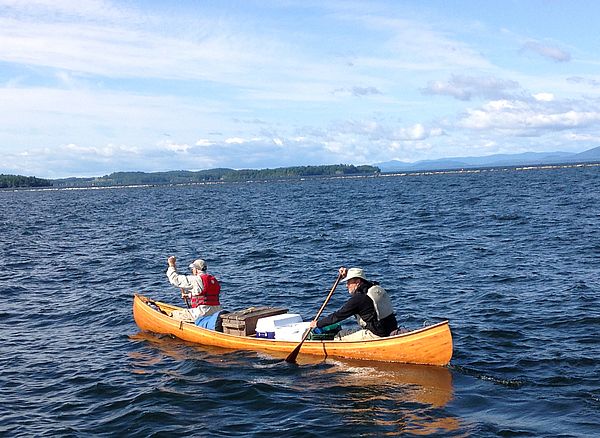In late June, LCC members John Little and Jim Wakefield headed down the lake in a handcrafted canoe on a paddle to New York City. Both are science teachers and experienced outdoorsmen, and they have paddled many waterways together. Below is John's account of the first leg of their journey.
PQ to NYC part #1
We loaded the canoes on June 28, a very rainy day. My partner Jim Wakefield and I kissed our wives goodbye in the downpour and said goodbye to long time friends who had come to see us off. Since that time, we’ve been traveling by canoe and foot everywhere we go. We have hit all kinds of weather, from hot and still (the kind of weather that bakes you into a stupor on the lake), to head winds that force you to stay on shore, rather than try to paddle into the waves.
We have realistically only seen a fraction of our great Lake Champlain, but it’s been a great vacation for the two of us. We traveled out of the Missisquoi National Wildlife Refuge delta, seeing the heron rookery in full swing. I noticed that there are now Bald Eagles found within the Refuge. Not too long ago, there were no large birds of prey to be found as a consequence of human uses of pesticides (DDT). This day we saw three separate immature Bald Eagles, and an adult. In addition, we saw Black Terns, Ospreys, and multitudes of Redwing Blackbirds. On the big lake in the next few days, we watched two kinds of Terns, three kinds of Gulls, a few Loons, Great Blue Herons, and a couple of Snowy Egrets. As we entered the very narrow lowest part of the lake we saw turtles on lots of logs hanging out in the sun to get their blood flowing. Reptiles have to do that sometimes.
Once we entered the lake, we headed down the Alburgh Passage, out through the Carry Bay causeway, down the west side of Grand Isle, through Burlington Harbor. After a weather-enforced rest day, we traveled down the Vermont side of the lake until the Crown Point Bridge. There we switched to the New York side and as the lake narrowed, paddled right down the middle when we wanted. At Whitehall, NY, we entered the Lake Champlain Canal System. It was pretty exciting to paddle the old canoe into a lock built for huge barges, and watch the waters rise. Once the doors were open on the other side, we were in the canal proper, and it wasn’t anywhere near as beautiful or scenic as the lake. It was straight for miles at a time, and the water quality wasn’t quite so clean. However, two days later, we left a lock, and entered the Hudson River proper. From there, with another day, we were locked down the Hudson to tidewater, and Troy, New York. Here we pulled the canoe out for a rest day, and met my wife and her daughter for dinner at a locally known brew pub.
The real story of the trip however, is the people we met. Some were old friends, some we were introduced to, and some were complete strangers. We were invited into folks’ homes to avoid foul weather, watch World Cup Soccer events, and share dinners with them. I really can’t get over how wonderful folks are when you need a hand, or just to say “Hi”! A prime example of this was a family who found us sheltering on their shoreline because we couldn’t go any further due to the wind. In spite of the "NO TRESPASSING SIGNS" posted prominently, this family invited us up to their home. They routinely have people use the shoreline for fires and parties and leave trash for the owners to deal with. Pretty rude by my standards! Instead, they invited us up for a Fourth of July steak and burger dinner, camping on their lawn, and fireworks from their deck.
OK, I guess I have to get back to work on the trip supplies. Because of the generosity of our friends (old and new), as well as stopping in a few restaurants along the way, we have not used much of our food supplies we so carefully packed. With the final stretch of our trip starting tomorrow (paddling down the Hudson River), we are going to carry a lot less food than we originally thought, which will make the canoe lighter.
